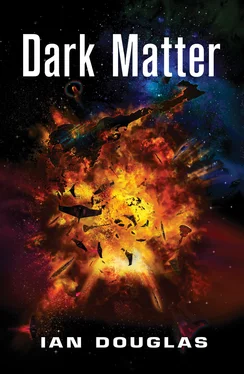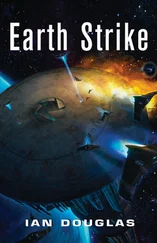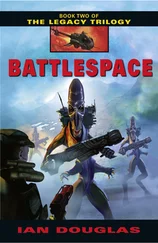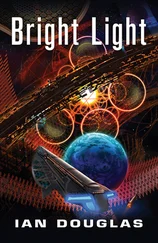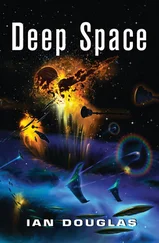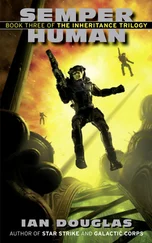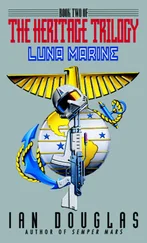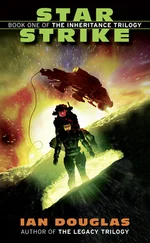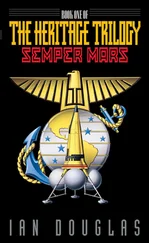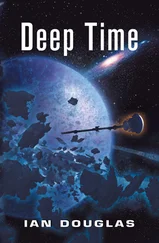Lieutenant Frank Gallagher accelerated at nearly 10,000 Gs, streaking up from the tiny white, icy moon and into open space. Above him, Saturn hung huge and vast and beautiful, filling half the sky, her rings a diamond-hard and ruler-straight white scratch across all of heaven.
“Enceladus Base!” he called. “Blue One clear and accelerating!”
“Copy, Blue One,” the voice of Enceladus Flight Control replied in his head.
“Joining formation.” The three other Starfighters of Blue Flight drifted in open formation a few thousand kilometers ahead and he moved to join them. “Okay, Blues,” he said. “Keep it tight.”
“Blue Two, affirmative.” That was Lieutenant Karyl Joyce.
“Blue Four, ready to boost.” Lieutenant Dwayne Tanner.
“Blue Three, ready.” Lieutenant Victor Truini.
“Blue Flight formed up and ready for formation intercept,” Gallagher announced.
“Copy, Blue Flight. Unknowns now bearing at one-seven-three plus twelve, range two-niner-five thousand. Unknowns have fired on Red Flight, and are confirmed hostile. You have weapons free, I say again, weapons free.”
“Copy weapons free. Coming to one-seven-three plus one-two.”
“Go get ’em, Frank.”
“No prob, Salad Bowl. Keep the coffee warm for us back there.”
“Will do.” The voice hesitated. “We’re reading the hostiles now as twelve Krag-sixties. Range now two-five-zero thousand. The big boys are moving in, range one-point-seven-seven million.”
Not good. “Copy.”
The Pan-European Krag-sixties—KRG-60 Todtadlers, or Death Eagles—were as fast, as maneuverable, and as heavily armed as modern USNA Velociraptors, which meant that they were much better than Blue Flight’s older Starhawks, especially at long range.
They would have to get in tight to make a difference.
But twelve of them! Blue Flight consisted of four Starhawks, and Red Flight of four more, assuming they were all still operational. The USNA defensive contingent at Enceladus was going to be badly outclassed in this engagement—and there were still the “big boys,” the Confederation capital ships, to contend with.
“Blue Flight, engage sperm mode,” Gallagher ordered. The external hulls of the SG-92 Starhawks softened and flowed, morphing into their high-velocity configuration—a rounded body with a long, slender spike at the tail. Streamlining wasn’t normally a factor in spaceflight—at least, not at normal planetary velocities. But minute flecks of debris—stray hydrogen atoms, for the most part—were definitely a consideration at higher velocities.
And, more to the point, the region of space close to Enceladus was not hard vacuum. The dazzlingly white moon was imbedded inside the thickest part of Saturn’s E ring; in fact, specks of frozen water streaming out from Enceladus were responsible for creating the E Ring, and for keeping it in existence. Though local space was still hard vacuum by terrestrial standards, flying through that blizzard of ice particles at high-G accelerations would be like plowing through an atmosphere of molasses.
“On my mark, boys and girl,” Gallagher told his flight. “Fifty-kay gees in three . . . and two . . . and one . . . and boost!”
Powerful, tightly wrapped balls of warped space flickered into existence off each Starhawk’s bow. In existence for only a tiny fraction of a second, each microsingularity lasted just long enough to bend space ahead, allowing the fighter to fall forward. By continuing to flicker on and off, the drive allowed the craft to bootstrap itself to higher and higher velocities . . . and since the fighter was in freefall, following the local curvature of space itself, there were none of the unpleasant side effects of acceleration—like having the pilot smeared across his acceleration couch in a thin, red stain. At 50,000 gravities, a Starhawk could nudge up against the speed of light in about ten minutes. They wouldn’t be boosting for that long, however. The idea was to engage the incoming enemy, not blow right past him at a high percentage of c. The fighters’ AIs cut off acceleration when the closing velocity was up to 5,000 kilometers per second, and the enemy was thirty seconds away.
“Prepare to engage,” Gallagher called. “Arm Kraits. Spread for area effect . . . but watch out for our Red Flight. Blue Four, hold yours in reserve.”
“Copy, Blue Leader.”
Kraits were nuke-tipped VG-10 antiship missiles. They were particularly effective against capital ships, but a near miss would fry a fighter’s circuitry and the expanding plasma sphere might shred hull matrix if the detonation was close enough. They weren’t as powerful or as long-ranged as the newer Boomslangs or Taipans, but they could do the job well enough with good tactics.
Gallagher watched the red points of light representing the enemy fighters drift across an in-head window, each accompanied by a small block of text describing the target’s mass, direction, speed, and acceleration. The friendlies out there were in full retreat . . . three of them dropping back toward Enceladus at high-G. A white sphere of light blossomed . . . and then there were two friendlies left. The hostiles kept closing.
Damn it, they should have ordered Red Flight to open up on the unknowns as soon as they’d become visible. Who the hell else had the Salad Bowl—the squadron’s pet slang name for Enceladus Station—been expecting out here?
He selected four Kraits, marked detonation points on his in-head to create a spread across the expected paths of the Confederation fighters, and triggered the release. “Fox One!” he announced. “Blue One, missiles away!”
“Blue Three! Fox One!”
“Blue Two! Fox One!”
Fox One was the code phrase indicating the launch of smart missiles—fire-and-forget warheads equipped with AIs to guide them to their targets. Released from the fighters’ bellies, the missile drives switched on an instant after they were clear to avoid changing the fighters’ vectors, sending them streaking into darkness. One vanished two seconds later, wiped from the sky by a Todtadler’s particle beam, but the others detonated in a pulsing one-two-three blossoming of white light. The enemy fighters had scattered off their path as soon as they’d detected the launch . . . but the spreads launched by Truini and Joyce had been placed to box the Todtadlers in, and as additional fireballs flared in the distance, two of the enemy fighters vanished, while a third, torn by an expanding plasma fireball, tumbled helplessly out of control.
But there were missiles incoming now, answering Blue Flight’s volley. Gallagher’s AI pegged the designation as AM/AS-9, which carried the USNA code name Black Mamba. The AM/AS designation stood for antimatter/antiship; rather than a nuclear warhead, it packed several grams of antimatter in a magnetic containment capsule, enough to generate a multi-megaton blast laced with deadly X-ray and gamma radiation. There were eight of them, pushing a 100,000 Gs. The Pan-Europeans, it appeared, were out for blood.
“Blue Four!” Gallagher called. “Try to block those Mambas!”
“Copy, Blue Leader! Fox One . . .”
For several endless seconds, two sets of artificial intelligences vied with each other tactically, each trying to outguess the other, feinting, dodging, putting on sudden bursts of acceleration, or decelerating sharply to spoof its opposite numbers. Then nuclear flashes erupted against the black of space, deathly silent, and half of the Mambas vanished in the blasts.
Four kept coming, their AIs seeking out the formation of USNA Starhawks for the kill.
“Blue Flight, go to E-and-E!” Gallagher yelled, breaking hard high and to port. E and E—Evasion and Escape. It was time to get the hell out of Dodge.
Читать дальше
